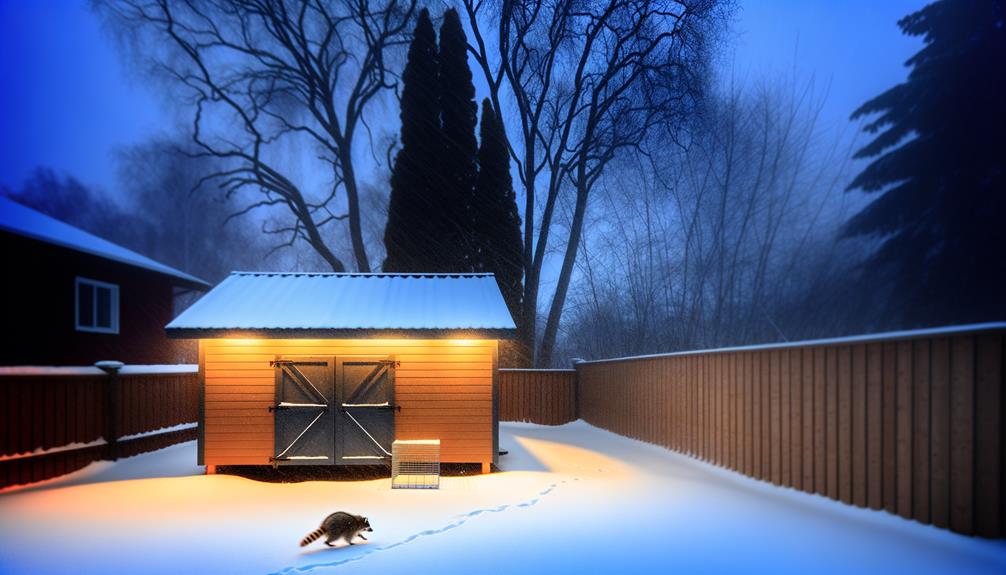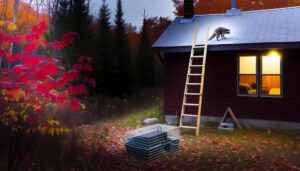Getting Rid of Raccoons from Your Property This Winter
To address raccoon issues in winter, first identify activity through tracks and disturbed trash. Secure entry points by inspecting and sealing gaps, cracks, and vents with steel mesh or heavy-duty caulk.
Employ live traps with baits like marshmallows in active areas, regularly checking traps. Use natural deterrents such as ammonia-soaked rags, peppermint oil spray, and predator urine around entry points.
For persistent issues, contact licensed wildlife removal professionals who use humane methods. Prevent future invasions by securing garbage, removing food sources, and installing motion-activated lights.
Discover additional strategies and expert tips for thorough raccoon control.

Key Takeaways
- Secure garbage bins with raccoon-proof lids and store them in a locked shed or garage.
- Seal all entry points by inspecting and fixing gaps, cracks, or holes in your home.
- Use ammonia-soaked rags or commercial repellents around your property to deter raccoons.
- Set up humane traps with bait like marshmallows or cat food, and release captured raccoons far from your property.
- Hire licensed wildlife control professionals for humane removal and long-term exclusion solutions.
Identifying Raccoon Activity
Frequently, identifying raccoon activity in the winter involves looking for specific signs such as tracks, droppings, or disturbed trash.
Raccoon tracks are distinctive; look for five-toed footprints with visible claw marks in the snow or mud.
Droppings are often found near feeding sites and resemble small dog feces but may contain undigested seeds or berries.
Additionally, overturned garbage cans or scattered refuse are telltale signs of raccoon scavenging.
To safeguard health and safety, always wear gloves when handling droppings or trash, as raccoons can carry diseases like leptospirosis and roundworm.
Document these signs meticulously to determine the extent of activity, which will inform subsequent steps in addressing the raccoon presence effectively and humanely.
Securing Entry Points
Once you have identified signs of raccoon activity, the next step involves thoroughly inspecting and securing all potential entry points to prevent their access to your home or outbuildings. Begin by examining your roofline, vents, chimneys, and soffits for any openings or loose materials.
Seal gaps and cracks using sturdy materials such as steel mesh or heavy-duty caulk. Confirm vents and chimneys are covered with firmly fastened caps or screens. Check doors and windows for proper sealing, and mend any damaged weather stripping. Inspect foundations and crawl spaces, fixing any breaches.
Prioritize safety by using appropriate tools and protective gear. By meticulously securing these entry points, you can effectively safeguard your property against raccoon intrusions during the winter months.
Humane Trapping Methods
When addressing humane trapping methods for raccoons during winter, it is crucial to start by selecting appropriate traps designed specifically for raccoons to guarantee their safety and effectiveness.
Once a raccoon is trapped, follow safe release practices, including choosing a suitable location far from human dwellings and safeguarding the animal's wellbeing during transport.
Always wear protective gear and adhere to local wildlife regulations throughout the process.
Selecting Appropriate Traps
Selecting appropriate traps for raccoons requires careful assessment of humane trapping methods to guarantee the safety and well-being of the animals. It is essential to choose traps that minimize stress and potential injury.
Here are four key points to bear in mind:
- Live Traps: Opt for live traps specifically designed for raccoons, as they ensure the animals are unharmed during capture.
- Size and Material: Ensure the trap is spacious enough (at least 32 inches in length) and constructed from durable materials to prevent escape and reduce injury risk.
- Bait: Use raccoon-friendly bait, like marshmallows or canned fish, to humanely attract them into the trap.
- Placement: Place traps in areas frequented by raccoons, avoiding hazardous locations to prevent accidental harm.
These guidelines help maintain ethical and efficient trapping practices.
Safe Release Practices
Securing the humane release of captured raccoons is essential to their safety and well-being, necessitating careful planning and execution.
Begin by selecting a suitable release location at least 10 miles away from the capture site to prevent their return. Make sure the area is free of human habitation and has abundant food and water sources.
During transport, use a secure, ventilated enclosure to minimize stress. Upon arrival, position the trap's opening toward natural cover, such as bushes or trees.
Open the trap slowly, allowing the raccoon to exit at its own pace. Maintain a safe distance to avoid startling the animal, ensuring your own safety and the raccoon's calm departure.
Always wear gloves and follow local wildlife regulations.
Using Natural Repellents
To effectively deter raccoons during the winter months, consider using natural repellents such as essential oils, predator urine, and homemade repellent recipes.
Essential oils like peppermint and eucalyptus can be applied to entry points, while predator urine creates an environment raccoons instinctively avoid.
Additionally, homemade repellent solutions can be crafted using common household ingredients to guarantee safety and efficacy.
Essential Oils Application
When considering the application of essential oils as natural repellents, it's important to focus on those known for their effectiveness in deterring raccoons, such as peppermint and eucalyptus. These oils can be used effectively through the following steps:
- Dilute the essential oils: Mix 10-15 drops of essential oil with a cup of water.
- Spray around entry points: Apply the mixture around doors, windows, and other potential entry points.
- Reapply regularly: Reapply the solution every few days or after heavy rainfall to maintain its strength.
- Use caution with children and pets: Ensure the oils are used in areas inaccessible to children and pets to prevent accidental ingestion or skin irritation.
Predator Urine Usage
Another efficient natural repellent for deterring raccoons, especially in the winter, is the strategic use of predator urine. This technique leverages the natural fear raccoons have of predators like coyotes or foxes.
To implement this method, purchase predator urine from a reputable supplier. Apply the urine around the perimeter of the area you wish to protect, focusing on entry points and potential nesting sites. Use gloves and apply the urine with a spray bottle or dispensers to guarantee safety and sanitation.
Reapply after heavy rain or snowfall, as weather conditions can dilute its impact. Always follow the manufacturer's guidelines for proper usage and storage. This humane method can markedly reduce raccoon intrusions without causing harm to the animals.
Homemade Repellent Recipes
Creating homemade repellents using natural ingredients can provide a safe and effective solution to deter raccoons during the winter months. Here are four recipes that utilize common household items to protect your property:
- Peppermint Oil Spray: Mix 1 cup of water with 10-15 drops of peppermint essential oil. Spray the mixture around entry points and garbage bins.
- Ammonia Solution: Soak rags in ammonia and place them near raccoon-prone areas. Make sure they are out of reach of children and pets.
- Cayenne Pepper Mix: Combine 1 tablespoon of cayenne pepper with 1 quart of water. Spray generously around the perimeter of your home.
- Garlic and Onion Blend: Blend one onion and a bulb of garlic with 2 cups of water. Strain and spray the liquid in frequented areas.
Professional Removal Services
Engaging professional removal services is essential for safely and effectively addressing raccoon infestations during the winter months. Trained experts possess the knowledge and tools to humanely capture and relocate raccoons, ensuring minimal stress to the animals and reducing potential harm to your property. These professionals adhere to local wildlife regulations, guaranteeing that all procedures are legal and ethical.
Additionally, they can identify entry points and nesting areas that might be overlooked by untrained eyes. When selecting a service, verify their credentials, request references, and confirm their use of humane practices. Prioritizing professional intervention not only mitigates immediate issues but also safeguards your home and family from the health risks associated with raccoon infestations.
Preventative Measures
Implementing effective preventative measures is crucial for deterring raccoons from entering your property during the winter months.
Here are four key strategies to guarantee your home remains raccoon-free:
- Secure Garbage Bins: Use raccoon-proof lids and store bins in a locked shed or garage.
- Seal Entry Points: Inspect your home for gaps, cracks, or holes, and use metal mesh or caulk to seal them.
- Remove Food Sources: Clear fallen fruit, pet food, and birdseed from your yard, as these attract raccoons.
- Install Motion-Activated Lights: Bright lights can startle and discourage raccoons from approaching your property.
Conclusion
To sum up, dealing with raccoon activity during winter requires a multilayered approach. This involves identifying activity, securing entry points, using humane trapping methods, incorporating natural repellents, and considering professional removal services.
Some may argue that these steps are extensive; nevertheless, thorough actions guarantee safety and deter property damage. Implementing preventive measures also reduces potential future problems, establishing a safe environment.
Ultimately, this robust strategy harmonizes compassionate treatment with efficient raccoon control, protecting both residents and their properties.






